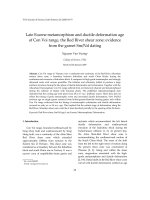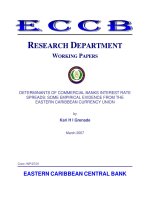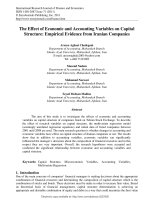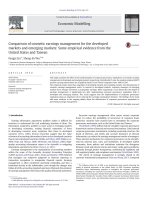HARMONIZATION OF PUBLIC COMPETITIVE TENDERING : EMPIRICAL EVIDENCE FROM THE MINISTRY OF HEALTH IN VIETNAM
Bạn đang xem bản rút gọn của tài liệu. Xem và tải ngay bản đầy đủ của tài liệu tại đây (88.9 KB, 19 trang )
1
ThAi nguyen University Southern luzon STATE University
Socialist Republic of Vietnam Republic of Philippines
____________________________________________________________________________
DISSERTATION ABSTRACT
HARMONIZATION OF PUBLIC COMPETITIVE TENDERING :
EMPIRICAL EVIDENCE FROM THE MINISTRY
OF HEALTH IN VIETNAM
Advisor : Dr. Alice T. Valerio
Name of Student : NGUYEN DUY PHUONG
English Name : NOAH
Date of Birth : 13-12-1974
Course : SLSU-DBA1
Hanoi May, 2013
2
PREFACE
This study aimed to describe the common and the unique provisions in the
International Law on Tendering (ILT) and Local Law on Tendering (LLT) in Vietnam
to determine how procurement and bidding are being done in the Ministry of Health as
measured in terms of openness and transparency; to analyze how can the ILL and the
LLT be harmonized in the Ministry of Health using transparency and openness as
factors of harmonization; and to formulate some recommendations to have a more
effective public procurement system. After using statistic tool, the Author defined a
efficient model which should be applied in Vietnam. Though title “Harmonization of
public competitive tendering: Empirical evidence from the Ministry of Health in
Vietnam”, preliminary results indicate there is one procuring method that meet both
Vietnam Law on tendering and International procuring regulations. It is International
Competitive Bidding (ICB) in which the sphere of openness as well as of transparency is
the best.
3
CHAPTER I
INTRODUCTION
1. Background of the Study
Efficiency in procurement has long been recognized as a way to obtaining the
desired goods or services at the lowest price or, more generally, at the best “value for
capital”. The most common practices of procurement involve some forms of tenders and
it is believed that, under these, efficient procurement outcomes can usually be achieved in
situations where there are enough firms in the procurement market to sustain reasonable
competition. In cases with a reduced number of firms, more sophisticated arrangements
are necessary to prevent practices such as collusion, fraud and corruption, which hinder
the achievement of efficient outcomes.
2. Statement of the Problem
1) What are the common and the unique provisions in the International Law
on Tendering (ILT) and Local Law on Tendering (LLT) in Vietnam?
2) How are procurement and bidding being done in the Ministry of
Health as measured in terms of openness and transparency?
3) How can the ILL and the LLT be harmonized in the Ministry of
Health using transparency and openness as factors of harmonization?
4) What changes on LLT can be recommended to make the procurement
system be effective?
3. Objectives
1. To describe the common and the unique provisions in the International
4
Law on Tendering (ILT) and Local Law on Tendering (LLT) in Vietnam;
2. To determine how procurement and bidding are being done in the Ministry
of Health as measured in terms of openness and transparency;
3. To analyze how can the ILL and the LLT be harmonized in the Ministry
of Health using transparency and openness as factors of harmonization; and
4. To formulate the best method to make the procurement system be more
effective.
4. Hypotheses of the Study.
- It was assumed that higher transparency and openness is the better preconditions
for a good procurement, competition in tendering, and for a better proportion between the
lower price and higher quality resulting in the effectiveness of tendering.
- It was hypothesized that openness and transparency are significantly affecting
harmonization in ILT and LLT in the Ministry of Health.
5. Significance of the Study
This study will benefit the government, PMUs, bidders, and other researchers.
The government can amend the law to remove the gaps of discrepancy between its
legislative system and international donor’s regulation related to procurement procedure.
As a result, there are more and more financial support for developing programs in
Vietnam. On the other hand, these donors shall get confidence that their funds are using
efficiently. Besides that, all available bidders will have equal opportunity to offer their
best quality products at lowest price in a competitive market.
6. Scope and Limitations of the Study
This study was not able to identify the source of changes in procurement
5
disciplines. It is also worth noticing that the analysis is not a comparison between
regulated and non- regulated tenders. There may be other intangible benefits related to
increases in quality, better tailored services, or innovative solutions which are not
recorded in the data and hence are not quantifiable in this study.
7. Definition of Terms
To provide a clear understanding of some of the terms that were used in this
study, the following important terms were theoretically and operationally defined:
- Legislation Harmonization refers to the process of creating common standards
across the competitive market aimed to create consistency of laws, regulations,
standards and practices, so that the same rules will apply to businesses.
- Public procurement is including all Investment and development projects which
are projects financed by the State as to 30 per cent or more.
CHAPTER II
REVIEW OF RELATED LITERATURE
1. Systems Theory
This section includes studies on the management system of many famous authors
directly related to the subject of this dissertation.
2. Administrative Theory
This section includes studies on the administrative management of some authors
directly related to the administrators of projects. There are some administrative theories
that have been applied seriously. Otherwise, the project could not be performed
smoothly.
6
3. Procurement Legislation Studies
A substantially larger quantity of research has been devoted to the structure of
procurement processes in order to achieve efficient outcomes under different situations.
The procurement literature records several tools for its effective procuring
implementation
4. Procurement Administrative Studies
The papers offer solutions primarily administrative reforms to public procurement
management from the central to local levels. Theare are some specific opinions for public
procurement administration reforms emphasized on quality and results over cost, and
decentralization of procuring.
5. Legislation of Vietnam and International Community for Procurement
Vietnam's regulations including legislative documents issued by the National Assembly
and the Government. The procurement rules of international law is subject to
procurement guidelines from donors or international financial organizations.
6. Conceptual and Theoretical framework
7
Figure 1. Conceptual framework of the study
Figure 1 shows how harmonization of two legislative systems that will measure
relationship between indicators of transparency and openness. Evaluation was based on
comparing two legislative systems and practice of applying procuring methods for public
project in the Ministry of Health. This study also reviewed and updated the new findings
and new regulations to see clearly the nature of current procurement. Eventually,
Harmonized
Laws and
Regulations
18 Factors:
Group 1. Openness
- International
tender
- Local tender
- Direct purchase
Group2.Transparency
- Public invitation
- Public award
National
Law
(LLT)
Effective
Procurement
System
International
Regulations
(ILT)
Ministry of
Health
(MOH)
Procurement
Practices
8
specific solutions to harmonize regulations on bidding between the laws of Vietnam and
relevant international law are offered.
9
CHAPTER III
RESEARCH METHODOLOGY
1. Research Design
This study employed three research designs as descriptive, causal/explanatory and
comparative types. Descriptive was used to describe the respondents in terms of age,
department, position, and working experiences of project administrators. Next,
comparative research design was used to determine if there was significant difference in
two law and regulation systems by referring to procuring articles of local and
international laws. Finally, causal/explanatory design was used when the Author
identified the relationship and effect of legislative harmonization, transparency and
openness in public procurement.
2. Time and Place of the Study
This study is on procurement administration which is based on latest data of two
legislation systems. Research is designed to get primary data from all provinces of health
care service Departments of Vietnam for the last five.
3. Sampling Procedures
Secondary data were obtained from 02 legal regulation system (Vietnam Law and
03 International organization’ regulation) which are up to date. Primary data were
collected using questionnaire method covering all 63 provincial Project Management
Unit (PPMU) of Vietnam.
4. Data Collection
Collecting information from researched subjects by Questionnaires is developed and
applied according to Figure 2. Research questionnaire was made through different
10
stages. First, survey research was studied or conducted through articles, scientific reports,
essays; second, the Author gets officers experts who are experienced in tender by
submitting a preliminary questionnaire to amend the questionare set. After this pilot
stage, the Author sent a formal questionnaire to individuals who are working in the field
of public procurement
5. Research Instrument
A five-point Likert scale was used for the scoring of indicators of legislative
harmonizing, transparency tender, and openness tender. It includes five scales: always;
frequent; sometimes; seldom; and never. Each of indicators was identified score based on
mean of 4 to 5 variables.
6. Statistical Treatment
The secondary data is compared to find out discrepancy from Vietnamese
procurement law and procurement regulation of WB, ADB, JIBIC in term of
transparency, openness, harmonizing. Primary data were processed by Statistical
Analysis for Social Sciences (SPSS) software. The harmonizing variable is dependent
and it is indicated by using the following formula:
Legislative harmonization = Transparency Procurement + Openness Procurement
7. Methods of Analysis
The results of the survey were analyzed in two parts. The first part was the
profiling of the respondents in terms of individual and profile. The second part was the
assessment of the procuring procedure applied of the respondents.
11
CHAPTER IV
RESULTS AND DISCUSSION
1. Provisions in ILT and LLT in Vietnam
It is the summary of discrepancies raised by the World Bank, ADB and JBIC/JICA
against the contents of the current Vietnamese Laws on tendering referring to
transparency and opening of tendering. Basing on practice of managing projects and
principles of applying Laws and regulations, some significant methods are used to
harmonize these legislative differences efficiently
2. Public Procurement Activities in
MOH
This research shows that if PMUs apply LCB procuring method, they also are
sometimes required to submitted higher government administrative Authorities. It means
these PMUs are more freely legal regulation on project management determination. They
are allowed to determine tendering schedule. It is not to much regulation to submit
bidding documents to Executing Agencies, Project Owner/Investor and Controlling
Agencies. It means these PMUs shall choose LCB procuring method instead of ICB
because LCB method is very simple and easy in submitting procedure of bidding
documents.
3. Procurement and Bidding Practices in Terms
Transparency and Openness Measures
Almost PMUs apply publishing tender document and use the most competitive
bidding method of ICB- International competitive Bidding. However, there are still
PMUs using non-standard purchase such as Direct Purchase for small value contract.
12
This proves that the PMU will gradually trend commonly applied method ICB bidding
instead of LCB to shopping. However, in the transition period LCB method still applied,
but with low frequency.
4. Formulation of efficient public procurement
According assumed regression model and researched data, all independent
variables are β coefficient relationship. It means all PMUs are applying regulations and
methods of procuring in generally. However the ICB- International Competitive Bidding
is applied with the highest β value which are the strongest affection to harmonization. In
competitive regards, it is more bidder participating the tender and resulting PMUs could
buy better quality goods at low price. The four independent variables are coefficient and
the Model is made again as follow:
Harmonizing two law systems = -1.204 + 0.182 (Transparency) + 0.520 (International
competitive Bidding) + 0.227 (Local Competitive Bidding) + 0.197 (Non standard
purchase) or it is brief as follow:
APM(y) = -1.204 + 0.182 PTI + 0.520UOP +0.227 URP + 0.197 NSP
The second, the Author will use SPSS for importing step by step independent
variables into the Model (by method of Stepwise in the SPSS sorfware) to remove
variable automatically if there is multicollinearity. The best model is selected with R-
square at 0.79. It is reflecting 79% of the variables in the model are explained.
In order test the coefficient of the Models, using ANOVA statistic showing the
Sig value of Models are 0.000 < 0.05 by the F-test reflects a consistent Model. On other
hand, T-test of the appropriateness of the independent variables in the models show VIF
is the standard criteria used to measure the phenomenon of multicollinearity. If the VIF>
13
10 reflects the phenomenon of multicollinearity between the independent variables in the
model. In this case, the result shows the VIF values of the independent variables are less
than 10 showed that is not multicollinearity phenomenon in the Models.
The coefficient of model ( R-square is at 0.624) indicated that the variables in
mode is interpreted as 62.4%. So the model is coefficient. According to above result,
there is 01 variable being highest coefficient. It is ICB- International Competitive
Bidding. This quantitative analysis is also meet resulting from the qualitative analysis
that ICB bidding method is the best one which is compliant with both Vietnamese Laws
and International Laws. The model is made again as follow:
Harmonizing two law systems = -0.658 + 0.688 (International competitive
Bidding) + 0.333(Local Competitive Bidding)
or it is brief as follow:
APM(y) = -0.658 + 0.688UOP + 0.333URP
This model have tested by SPSS software and show the effects of the independent
variables on public procurement practices are estimated using ordinary least squares.
The result is the R- square of 0.624 indicates that the Linear regression model accounts
for well nearly four-fifth of the variance in the scale of public procurement practices.
However, it is important to recall that the current research is focused on examining
hypothesized relationships, not on providing a comprehensive representation (model) of
public procurement practices.
14
CHAPTER V
CONCLUSION AND RECOMMENDATIONS
1. Summary
In the procurement of goods for public use, that funds from incentive loans for
development, aid, grants of individuals and foreign organizations belong to the
management of the State budget, etc which Vietnam government guarantees, always is
difference between the provisions of the sponsors and procurement-tendering Laws of
Vietnam. Therefore, in the implementation process, the application a certain system of
law or regulation is extremely difficult for investors as well as the contractors to comply
with two law systems. It is hard to find out the most effective bidding method. Because,
in fact that the procurement of international competition which uses the above funds are
implemented from planning step to organizing tender for signing sale contract and
implementing contracts are placed in the territory of Vietnam, but the funds are from
foreign donors through the loan agreements or financing assistance. In principle, this
means that concepts and procedures for effective implementation of the tender must
comply with the provisions of Vietnam law on bidding, but in case there is any
discrepancy in the procurement procedure between the domestic regulations and donor
guidelines, the donor regulation shall overrule. It means the procurement regulations of
donors or Loan Agreements shall apply firstly. So for the project management unit
(PMU), the provisions of the "discrepancy" is very difficult to be aware and understood
where to apply the conflILL rules of "discrepancy". Methods of resolving is suggested
for effective procurement activities. In this dissertation, it will focus on the analysis of the
15
fundamental differences between local law and international law on the interpretation, the
express terms, as well as the important issues in the tender to indicate solutions from
which to harmonization regulations and laws that difference by proposing the best
method of tender for public procurement.
2. Conclusions
The research's results show the positive and significant effects of procurement
disciplines related to increasing openness and transparency from comparing the
provisions of the "discrepancy" between local law and international law.
The research finds that the Law and regulation on public tendering have resulted
in greater transparency. This has been accompanied by greater levels of openness in
procuring activities. The legislative rules have achieved measurable efficiency through
competitive market. The research has also found that differences in implementation and
application of the Laws and regulation have led to different outcomes in choosing
procurement method.
In the outcome model, author finds that the transparency and opening tender
effect strongly to harmonization of the two legal systems. If the International
Competitive Bid (ICB) is applied, it shall be complied between Vietnamese Law and
international legislative regulation. The use of non- standard procedures such as direct
purchase or local competitive bidding (LCB) is associated with a lower harmonizing
level between two legislative systems.
In this thesis, the author quantifies the relationships between public procurement
legislation and procurement practices where the indicator of openness is the greatest
affect to legal harmonization. In term of openness, it is then proved out the best model
16
of procurement called as ICB (the 'ICB model'- International Competitive Bid model).
Trong lu
ận án
này, tác gi
ả
đ
ã
đ
ịnh lượng
đư
ợc
m
ối quan hệ giữa
quy đ
ịnh trong
luật đấu thầu và thực tiễn hoạt động mua sắm, trong đó mức độ công khai có nhất ảnh
hư
ởng
l
ớn nhất
đ
ến
s
ự hài hòa
pháp lu
ật
v
ề mua sắm công
. Ti
ếp theo, khi tiếp cận tính
công khai, hình th
ức đấu thầu cạnh tranh quốc tế
- ICB đ
ã
được chứng mi
nh là hình th
ức
mua s
ắm tốt nhất
.
3. Recommendations
The legislative conditions currently prevailing entail practical difficulty and
confusion in such a way that the public procurement regulations are to be found in many
different places in the legislative system and therefore one encounters difficulty to
access and grasp them properly and smoothly. Without perfect knowledge to precisely
find suitable regulations to be applied to a particular procuring situation in question, one
can hardly carry out the process of tender in a legally appropriate manner. Therefore, it
is recommended that:
(i) Vietnam Government should systematically review all the existed
regulations relating to public procurement implementation and management project in
order to identify those overlaps, inconsistencies, overlaps and discrepancies contained,
and arrange them to specify which regulation shall take precedence over the others, and
(ii) A single law code is built up to apply to the public procurement
implementation and project management. It should be aimed at extracting effective
stipulations being currently applied.
Administrative management of PMUs should be also strengthened and measured
through the legal status of PMUs and training for project administrators. The legal status
17
of PMUs should be more clearly in terms of its administrative status, organizational
structure, external relationship with other relevant agencies. Finally, staff training is to
be strengthened with materials carefully prepared to ensure its quality and effectiveness.
In this regard, it is badly needed to hold PMUs staff orientation training in which the
PMU staff has to be provided with the following study materials:
(i) International major Donor’s Loan Procedure Handbooks or Guidelines
which sets out the general principles and procedures to handle loans of WB, ADB,
JICA . The purpose of these Handbooks and Guideline are to provide all relevant
parties with a clear pILL ures of necessary procurement procedure and to explain in
greater depth the parallel comparison of operational flows of the Project Cycle:
International donors’ and Government’s official public procurement procedures
respectively. During this comparison, the Handbook should point out common contents
of respective procedures of Vietnamese Laws and International regulation that should
be done jointly and simultaneously, discrepancies between them, and accordingly
suggest the possible remedies to harmonize in order to expedite the process and
smoothly proceed to the next steps. For each stage of procurement cycle, there should
be a detailed description of necessary steps, agencies/bodies in charge and to be
involved, required time frame within which each agency/body concerned must issue its
approval or opinion. In addition, the Handbooks should provide standard forms of
bidding document; formats of necessary document which must be completed by relevant
agencies/bodies;
(ii) Procurement Management Handbooks which provides the PMUs staff
with sound procuring management concepts and techniques to enable them to apply
18
them during the implementation under complicated bidding situations. These
Handbooks should cover all items relating public procurement management, including:
(a) planning the execution of procurement; (b) directing the activities required in
procurement execution; (c) monitoring the progress of the procurement well as
controlling and solving problems that may occur in bidding; and (d) gathering lessons
from experience that will assist better planning and management of future procurement
projects. It has been stressed that the projects preparation involving the both Vietnam
Government and the international donors, and should be conducted in a harmonized
procedural flows with close communication and collaboration with each other. The
Vietnamese public procuring procedures along the regulation framework supported by
the backbone regulation under Law on Tender 2005 is precisely implemented.
One of the most significant problems is the inharmonious operational process
among the parties involved in the project preparation stage, and resultant delays of the
project implementation after the loan agreement. As a base for solving this problem,
author is of the opinion that a harmonized as well as a consistent procedural flow of the
project preparation should be established being supported by a General Framework
agreement, which includes clear procurement procedural steps taken by Vietnam
Government and international organizations/ governments.
Following points are important in public procurement but have found to be
relatively weak in the prevailing procurement regulations:
(i) StrILL ly utilization of “two stages bidding” method including with use
as many as possible the kind of International Competitive Bidding (ICB)
(ii) Requiring that bidding plans be available and approved as early as
19
possible during the preparation stage.
(iii) Information control on tendering should be strILL er, particularly for the
stage of tender invitation and evaluation.
(iv) Evaluation criteria should be clearly and rigidly determined publicly
before the evaluation process commences, and these criteria should be firmly applied.
(v) Utilization of Procurement Consultants should be encouraged.
Above recommendations should be considered and researched officially to
ensure that the public procurement is transparency and competitive in market
mechanism. Finally, during the stage of reforming, changing tender laws, the project
management units should apply the best procuring method as International competitive
Bidding for all public procurement. It shall be avoid of the legislative conflILL
phenomenon. On other hand it is the best way that could buy the best quality goods with
full specification options at the lowest price.









